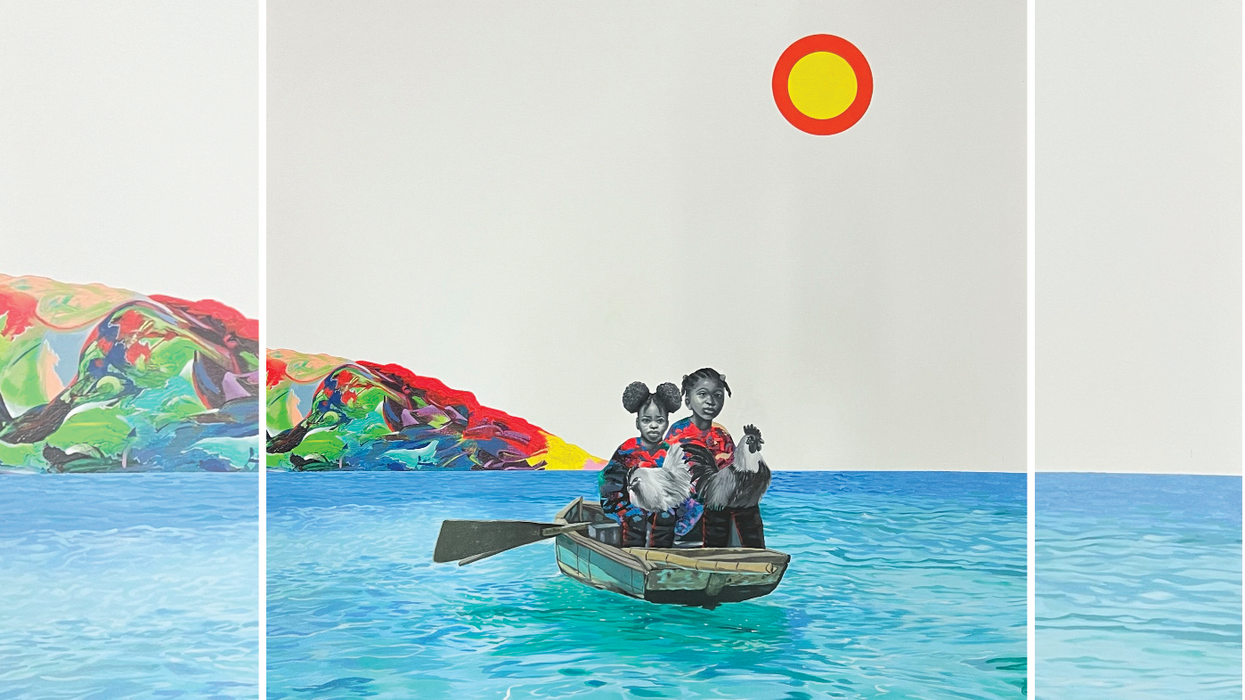Hatian-Houstonian Explores All Sides of Identity — and the Degrees to Which Those Feel Welcome — at Jung Show

'Caribbean Blues' by Baptiste
AT THE OPENING of Haitian-born Mathieu JN Baptiste’s exhibit Dyaspora, currently on view at The Jung Center of Houston through Dec. 21, Baptiste’s good friend and fellow Haitian Jean Michel Celestin surprised the gathering with a blessing he played on a shofar, an ancient instrument typically made of a ram's horn and used for Jewish religious activities. Celestin chose the shofar for its similarity to the cylindrical trumpets blown in Haiti to celebrate Batay Vètyè, or Battle of Vertières Day, which commemorates the last major battle of the Haitian Revolution, and the end of colonial rule in Haiti (then Saint-Domingue).
It was the perfect way to bring folks together at a cross-cultural (and very Houston) gathering for an artist whose paintings, sculptures, and works on paper speak to his Haitian heritage, the politics that compel people to leave their homeland in search of a safer life, and the surreal experience of feeling both welcome and unwelcome in a nation of immigrants.
Baptiste relocated to Houston in 2013, and became an American citizen last year. After passing the tests, swearing the oath of allegiance, and receiving a little American flag, he was surprised at how strange it felt to suddenly be an American but still Haitian.
“I speak Haitian, I still speak English with an accent, and I just received this paper that says, ‘Hey, you’re American.’” says Baptiste. “But what does that look like?”
Inspired by a photograph his wife took of him soaking in a bathtub after an exhausting day of exploring a coffee plantation in Mexico, where the couple observed people grinding coffee by hand, Baptiste addresses that question with “Soaking Adjustment,” one of the most oblique yet revealing paintings in Dyaspora. “It’s like half of me is being washed off,” says Baptiste of the self-portrait, with its large swaths of empty, blank space. “But my head is above water as if to say, ‘Hey, remember: I’m Haitian too.”
The sun, painted in bright yellow and orange, appears in several paintings in Dyaspora. Baptiste began thinking about the sun in relation to his art after a discussion with a friend who, like so many other Haitian immigrants, had made the arduous journey from Haiti to the Texas border on foot through heavily forested stretches of land where trees block one’s view of the sky. In “Caribbean Blues,” two young girls calmly navigate a tiny raft in deep blue waters, each one holding a rooster, the patterns of their clothing matching the landscape behind them. It’s a beautiful, but unnerving image. These two are on their own, but the sun hovers above them, like a compass for a journey, and a symbol of hope for a new day.
In a space adjacent to the exhibit is a room of Haitian artifacts from the collection of Sledge Leonidas, vice chairman for Houston Haitians United. The array of objects, including small standing statues, masks, hand drums, and seashells transforms Dyaspora into an even more immersive experience for the viewer. On Dec. 7 at The Jung Center of Houston, Leonidas will join Baptiste for a discussion about the show and their shared heritage and histories.

- Major Gift in Memory of Beloved Activist 'Transforms' Nonprofit, Will Help Treat and Prevent Burnout ›
- Isaac Mizrahi Speaks Out on Creativity and Mental Health: Meet the Fashion Icon at Jung Center Benefit ›










